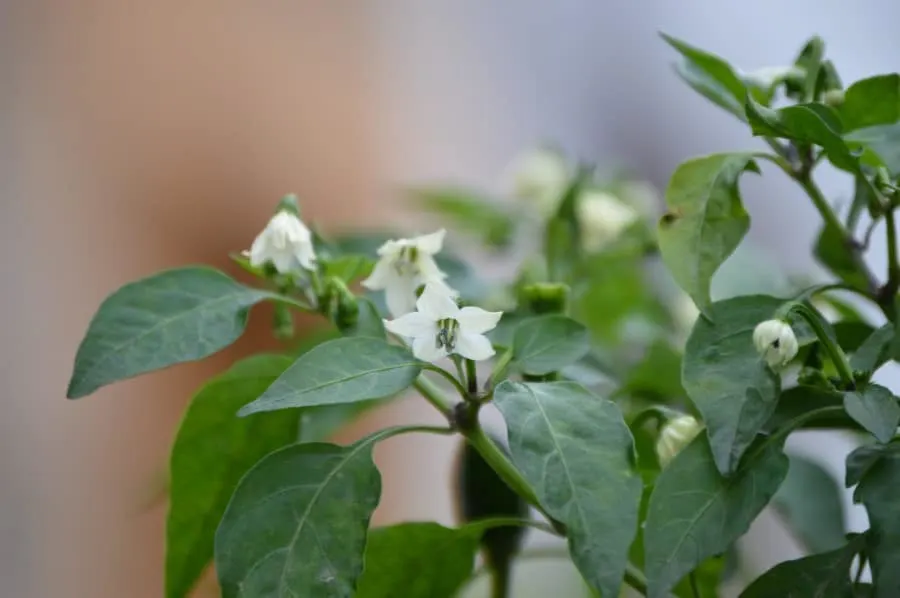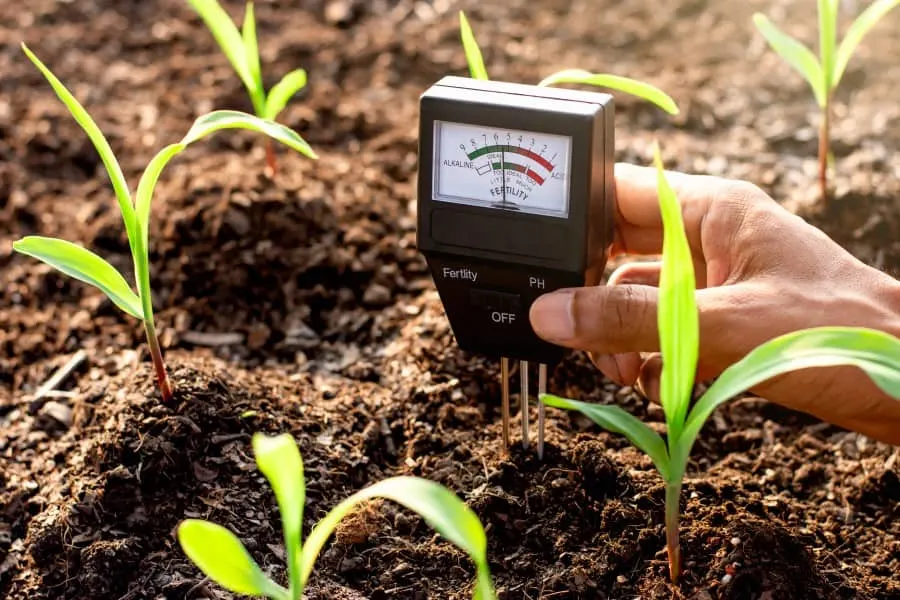Growing pepper plants is a somewhat long process but the reward at the end is a delicious and possibly spicy pepper. If your pepper plant isn’t flowering, however, it cannot fruit, which is frustrating. Why do some pepper plants not flow and how can you fix it?
A pepper plant won’t flower if its growing environment is out of balance. There could be a problem with the temperature, water, soil, nutrients, or a disease or bacteria might be interfering with the plant’s growth and development. Adjusting the environment will help your pepper plant flowers grow.

7 Common Reasons Why a Pepper Plant won’t Flower
It’s the Wrong Temperature
Pepper plants are extremely sensitive to temperature. They are warm-weather plants that thrive on six to eight hours of sunlight every day. The optimal temperature range for pepper plants is 65 to 86 degrees Fahrenheit (18 to 30 degrees Celsius) and too much deviation from this range can hurt the plant.
If the temperature frequently falls below that range during the growing season, particularly if the temperature drops drastically at night, the pepper plant won’t flower because it doesn’t have the necessary energy to grow. On the other hand, if the temperature goes above that range too frequently, it can dry out the buds, which will fall off the plant before they bloom.
Because peppers are picky about their temperature, this is one of the most common reasons a plant won’t flower.
Inconsistent Watering
Another common flowering issue for pepper plants is inconsistent watering. Pepper plants do best with about an inch of water every week. If they go through periods of either drought or overwatering, it can impact the plants’ ability to flower.
The best way to avoid this issue is to use a steady watering technique like drip irrigation. It’s also helpful to put a layer of mulch over the roots if your plants are outdoors to keep them cool and damp.
Using the finger test is a good way to water your plants as needed. To do this, simply touch the soil with your finger and if it’s damp, hold off on watering, and if it feels dry, go ahead and water your pepper plant.
Using the Wrong Soil
Another environmental factor that can impact your pepper plant’s ability to flower is the soil, as they need soil that drains well but also retains some moisture. Using sandy or loamy soil with a lot of organic material (like leaf litter or compost) can help. This type of soil will stay moist longer, letting the plant soak up food and water at a steady pace, which helps even growth. The sandy component will help with drainage.
Soil with a strong organic component can retain water and nutrients for long periods.
Peppers also prefer a pH-neutral environment. If you’re growing indoors, you can choose a potting soil to match your pepper’s needs, but if you are growing them outdoors, you should get your soil tested in the area where you want to grow the peppers. Then you can make adjustments to that soil as needed.

The Nutrient Balance is Off
Peppers have an ideal nutrient balance that is higher in phosphorus and potassium than nitrogen. They do need nitrogen, but too much will prevent them from flowering. Excess nitrogen in the soil will cause the pepper plants to put all of their energy into growing foliage at the blossoms’ expense.
All-purpose or universal plant foods and nutrient-mix soils are not going to do your pepper plants any favors, but if you add a little nutrient mix with more phosphorus and potassium for a week or so should encourage your pepper to bloom.
If there’s too much nitrogen in your soil, you can also add some bone meal to it, which soaks up the excess nitrogen.
You Might Have a Bacterial Problem
When your temperature, soil, water, and nutrients are all exactly where they need to be, but your peppers still won’t flower, you could be looking at a bacterial problem. Small worms called root-knot nematodes spread bacteria to plants in warm climates, like peppers.
Adding fish emulsion to your soil can help prevent the nematodes from spreading bacteria.
The most common bacterial issues for peppers are cankers and spots. These bacteria create spots and lesions on the leaves of the pepper plant, and if left untreated, they can eventually kill the plant. Because these bacteria spread via the soil, it is important to treat the area with a fungicide, or the infection could spread to new plants in a future growing season.
A Pepper Plant Disease Might Prevent it from Flowering
In addition to bacterial infections, several diseases can harm your pepper plant’s growth and prevent flowering. Blossom-end rot is a common disease that results from a calcium deficiency. Without enough calcium, the plant cannot build up strong cell walls, causing the blossoms and fruit to collapse and rot. Adjusting the calcium in the soil will help.
Southern blight is another common disease for peppers, which is caused by fungi that cover the roots and stems of a plant and interfere with nutrient absorption. The fungi are often visible on the stem and soil: they are white and wispy and tend to form mats around the plant.
Unfortunately, once your plant is infected, it will not recover. You should remove any infected plants as soon as possible to protect the rest of your garden.
Wilting Prevents Pepper Plants from Flowering
When your pepper plant wilts, it’s because it isn’t getting everything it needs to survive. Whether it’s an issue with the soil or water, or a pest or disease, something is interfering with the pepper plant’s ability to grow. If your pepper can’t grow, it won’t produce flowers or fruit, so if you see your plants starting to wilt, take action!
Can You Fix Your Plant After it has Started to Wilt?
Once a plant has started to wilt, it can feel like you’ve already lost the fight. However, many minor issues that cause wilting can be resolved and you might be able to bring your pepper plants back to full strength. The earlier you notice the problem and start treating it, the more likely it is you can save the plant.
There are some pests and diseases that can kill your plants very rapidly, but they are uncommon. If your pepper plant isn’t thriving, take stock of the environment and make adjustments to water, soil, nutrients, and temperature one at a time until you see results. Treat any spots or diseases as soon as you notice them for the best results.
Ways to Prevent Pepper Plants From Wilting
The best way to stop your pepper plants from wilting is to set them up in ideal conditions from the beginning. Before you plant your first seeds, find a sunny spot and a balanced potting mix. Set up a quality irrigation system and test your soil temperature. It’s easier to make adjustments later down the road if you know what the starting conditions were.
Closing Thoughts
Growing pepper plants can be tricky, but if done right, it’s extremely rewarding. If your pepper plant doesn’t bloom when it should, it doesn’t mean the whole crop is lost. By making careful, deliberate adjustments to your plants’ environment, you can encourage them to bloom.
Knowing the ideal temperature, water levels, soil composition, and nutrients for a pepper plant is crucial for growing a healthy crop. While bacteria and diseases can set you back, most of them can be treated. A wilted plant isn’t the end of the road; it’s just your pepper letting you know it needs something.
Here are Some of my Favorite Gardening Products and Tools
Thank you for reading this article. I hope you found it helpful for growing some new plants in your home or garden. Here are some products I like that I hope you’ll also find helpful. These are affiliate links, and I am compensated for referring traffic. But in all honesty, these are the exact product that I use or recommend to everyone.
Soil: For high-quality soil, I really like Fox Farm Ocean Forest. I do all my growing in containers and this soil has worked great for me. I like how they use nutrient-rich contents like earthworm castings, bat guano, and composted crab and fish.
Fertilizer: Currently I am using a seaweed-based organic fertilizer call Neptunes Harvest. This is a great milder fertilizer option if you want to use something organic. If you want a more powerful fertilizer, I recommend Fox Farm Liquid Nutrient Trio, lots of people have had great growing success with this product.
Pruning Shears: Pruning shears are one of the most useful gardening tools to have because it’s important to prune your plants to keep them healthy. The pruning shears I recommend are the Gonicc 8’’ pruning shears. I like them because they are built sturdy and work both on bigger and smaller plants, so you don’t need to have multiple pruning shears.
spicytrio.com is a participant in the Amazon Services LLC Associates Program, an affiliate advertising program designed to provide a means for sites to earn advertising fees by advertising and linking to Amazon.com. spicytrio.com also participates in affiliate programs with other sites. spicytrio.com is compensated for referring traffic and business to these companies.
